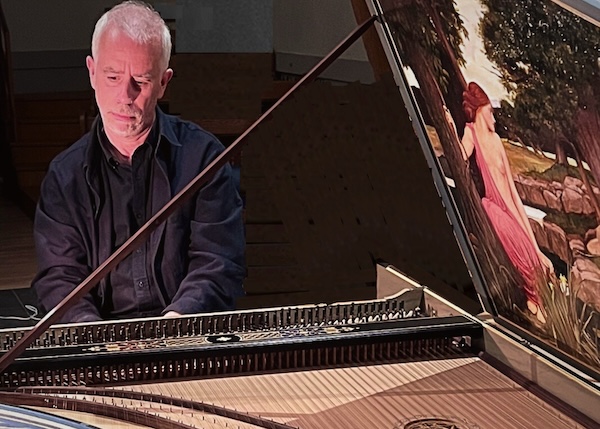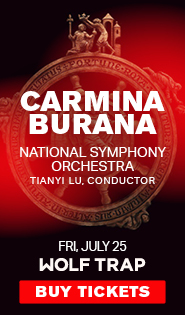French harpsichordist returns to Capriccio Baroque under cover of darkness

Pierre Hantaï performed a concert for Capriccio Baroque Saturday night at St. Columba’s Episcopal Church. Photo: CB
Two concerts by Pierre Hantaï closed out the season of harpsichord recitals presented by Capriccio Baroque. The French harpsichordist’s second performance, heard Saturday evening at St. Columba’s Episcopal Church in Tenleytown, focused on the music of J. S. Bach, but with a few twists.
For the first curveball, Hantaï chose to perform in darkness: putting the lights out, except for two small spots on the Colin Booth harpsichord, seemed an eccentric, hieratic gesture. The intention was to separate the listener from practical concerns about what piece is being played and just listen. Working against that aim, Hantaï’s spoken interludes took us right back into those very concerns.
Another disorienting tic was the decision not to publish a complete program, allowing Hantaï to move randomly from one piece to the next, often without announcing what he was playing. So the first set of pieces opened with Bach’s Aria variata alla maniera italiana, or rather just the A minor Aria from that work, without any of the variations.
A series of unrelated pieces succeeded one another in a chaotic jumble. These pieces sounded like a prelude, a sarabande, an allemande, a chorale prelude, a toccata, a slow aria, and a fugue. Like the Aria that began the set, they often featured elaborate embellishments on section repeats, along with registration and textural changes to add variety. Hantaï’s finger technique was fairly accurate, with occasional stray keystrokes serving as signs of human fallibility.
In the interest of a quiet acoustic, the air handling system was turned off, which meant that the room temperature and humidity, over the course of a nearly two-hour recital played without intermission, caused some tuning problems. Hantaï spent considerable time at two points in the evening trying to touch up the instrument’s intonation, especially in the upper range, another interruption to the flow of the music in the darkness.
Hantaï played the remaining pieces in their entirety, beginning with the chorale setting “Wer nur den lieben Gott lässt walten.” This delicate piece proved a melancholy highlight, a sort of interior monologue or prayer before the flashier secular pieces that followed it. As if to provide a transition from it, Hantaï improvised an intonatio, a prelude of arpeggiated chords and scalar flourishes settling the listener into the key of A minor.
This set the scene for the next work, the English Suite No. 2 in A minor. In its lengthy prelude, Hantaï used dynamic and textural shifts to highlight Bach’s imitation of an Italian concerto movement, with its ritornello recurring after softer solo episodes. Bach wrote a sudden end to one of these episodes, on a surprise diminished-seventh chord quite distant from the key center. The gesture calls for an improvised cadenza, which is exactly what Hantaï added in response.
Déjà vu set in at this point, stirring memories of Hantaï’s recital in Washington back in 2008, where there was the same lack of lighting, the same improvised introduction, and the same English Suite. Hantaï limned each of the following dance movements with nuanced shading, adding ornate embellishments. One model for this highly decorative approach is Bach’s own written-out ornamentations for the Sarabande movement, which show the sort of lavish treatment that was expected in Bach’s time.
Citing the influence of French music on Bach, Hantaï interpolated three pieces by François Couperin before the final Bach selection. This French music offered another hint about the florid, trill-heavy ornamentation style favored by Hantaï. Couperin’s musical portrait of the virtuoso Forqueray rustled with restless figuration, while delightful hesitations enlivened the dry wit depicted in “La petite pince-sans-rire.”
By the time Hantaï got to Bach’s Partita No. 6, one regretted his decision to eschew an intermission. The harpsichordist gave vivid readings of the piece’s many movements, not neglecting intricately embellished repeats of each section. Bach left two versions of the concluding Gigue: one in compound meter, which sounds like an Irish jig, and one in simple meter, more like a fugue. Hantaï decided to play both of them, the latter after the former.
A single encore followed generous ovations: a Sarabande from one of Bach’s solo cello suites, as arranged for harpsichord by Gustav Leonhardt, one of Hantaï’s most distinguished teachers. The sanctuary lights switching back on suddenly made for a jarring transition back to reality.

